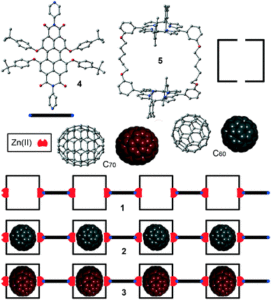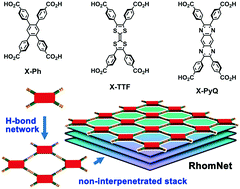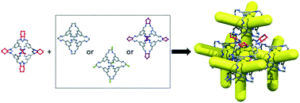Earlier this year we published a Themed Issue focusing on the design strategies for the construction of porous organic materials, including covalent organic frameworks (COFs) and organic cage structures. Featuring contributions from some of the leaders in this captivating field and guest edited by Rahul Banerjee and Neil R. Champness. See their editorial, check out the full contents, or read on for some of our selections of great articles from this issue.
|
Flexible monomer-based covalent organic frameworks: design, structure and functions
CrystEngComm, 2017,19, 4868-4871 |
 |
In this work by Zhou et al. the first example of a COF based on flexible monomers is reported. The material was synthesised by carrying out a Schiff base condensation between a rigid, aromatic carbonyl and a flexible amine. The resulting structure was found to be highly crystalline and porous, with a honeycomb-like hexagonal array of 1D channels (as seen in the cover art). The gas adsorption properties were studied and the material was found to demonstrate promising carbon capture capabilities.
|
Solid-state inclusion of C60 and C70 in a co-polymer induced by metal–ligand coordination of a Zn–porphyrin cage with a bis-pyridyl perylene derivative CrystEngComm, 2017,19, 4911-4919 |
 |
The interactions between porphyrins and fullerenes is interesting not just from a supramolecular point of view, but also due to the potential photochemical and conducting properties demonstrated by these pairs. In this work by Frontera et al. bis-porphyrin macrocycles are connected into 1D chains using extremely bulky perylene linkers. The size of the linker prevents it from acting as a guest in the porphyrin cage – leaving this site vacant to bind fullerenes as guest molecules. The authors found that occupancy of these cages was 100 % and went on to use computational methods to study the host-guest interactions present in these systems.
|
Precise elucidations of stacking manners of hydrogen-bonded two-dimensional organic frameworks composed of X-shaped π-conjugated systems CrystEngComm, 2017,19, 4892-4898 |
 |
A problem that has plagued the development of 2D COFs is that they generally exhibit low crystallinity, hindering characterisation. In this work by Hisaki et al. a series of X-shaped building blocks are linked by hydrogen-bonds to form 2D rhombic networks. These sheets stack without interpenetration to form low density frameworks. The aromatic cores of the monomers influence the stacking of these sheets, in two cases resulting in 1D inclusion channels. This in-depth structural analysis of these materials could enhance our understanding of the structures, stacking, and interlayer interactions of 2D COFs.
|
Modular assembly of porous organic cage crystals: isoreticular quasiracemates and ternary co-crystal CrystEngComm, 2017,19, 4933-4941
|
 |
In this paper by Cooper et al porous materials are formed by coupling the synthesis of porous organic cages (POCs) with a crystal engineering approach, relying on the intermolecular interactions between cages to direct their co-crystallisation. Rather than rely on the strong, directional intermolecular interactions that are typically used to design co-crystals, but which are often incompatible with cage synthesis, the authors relied on chiral recognition between opposite handed pairs. Combining a chirally pure POC with a helical racemate forms new, quasiracemates in which the POCs stack window-to-window to form diamondoid pores.
Submit your research on porous organic materials to CrystEngComm – see our author guidelines for information on our article types.
Find out more about the advantages of publishing in a Royal Society of Chemistry journal.










